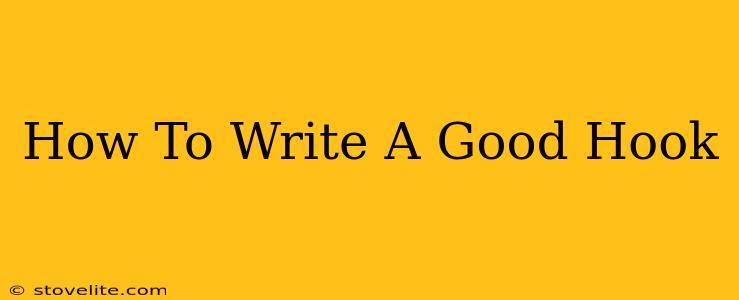A captivating hook is the cornerstone of any successful piece of writing. It's the first impression, the initial spark that ignites a reader's interest and compels them to continue reading. Whether you're crafting a blog post, a novel, or a marketing email, a strong hook is crucial. This guide will equip you with the tools and techniques to write hooks that grab attention and leave a lasting impact.
Understanding the Purpose of a Hook
Before diving into specific techniques, let's understand why a hook is so vital. A good hook serves several key purposes:
- Grabs Attention: In today's fast-paced digital world, attention spans are shorter than ever. Your hook needs to immediately capture the reader's attention and prevent them from scrolling past.
- Creates Curiosity: A compelling hook piques the reader's curiosity, making them want to learn more and discover what comes next.
- Establishes Tone and Style: Your hook sets the overall tone and style of your writing, giving readers a sense of what to expect.
- Provides Context: While not always necessary, a well-crafted hook can provide a brief glimpse into the topic, setting the stage for the main body of your text.
Types of Hooks That Work
There are numerous ways to write an effective hook. Here are some proven techniques:
1. Start with a Question
A thought-provoking question can instantly engage the reader. For example, instead of stating, "Stress is a major problem," you could ask, "Are you feeling overwhelmed by stress?" This immediately invites the reader to reflect and consider their own experiences.
2. Use a Bold Statement or Statistic
A surprising or shocking statement can also be highly effective. For example, "90% of people struggle with procrastination" immediately grabs attention and hints at a relevant problem. Similarly, using a strong statement like "Sleep deprivation is silently sabotaging your productivity" can immediately resonate with readers.
3. Begin with an Anecdote
Sharing a brief, relatable story can connect with readers on an emotional level. A personal anecdote or a short story related to your topic can be a powerful way to establish a connection and draw readers in.
4. Employ Vivid Imagery and Sensory Details
Using descriptive language that appeals to the reader's senses can create a captivating opening. Instead of simply saying "The city was noisy," you could say, "The city roared with a symphony of car horns, sirens, and chattering voices."
5. Create a Sense of Mystery or Intrigue
Starting with a hint of mystery or intrigue can leave readers wanting to know more. This works exceptionally well for storytelling and suspenseful writing. A phrase like "She knew something was wrong, but she couldn't place it..." immediately sparks curiosity.
Writing a Hook: Practical Tips
- Know Your Audience: Tailor your hook to resonate with your target audience. What are their interests and concerns?
- Keep it Concise: Brevity is key. Your hook should be short, sweet, and to the point.
- Be Specific: Avoid vague or generic statements. Focus on a specific aspect of your topic.
- Revise and Refine: Don't be afraid to experiment with different hooks and revise your work until you find one that truly captures the essence of your writing.
Beyond the Hook: Maintaining Reader Engagement
While a great hook is essential, it's only the first step. To keep readers engaged throughout your writing, you need to:
- Maintain a strong narrative flow.
- Use clear and concise language.
- Provide valuable information or insights.
- Break up text with headings, subheadings, and visuals.
By mastering the art of writing a compelling hook and implementing these additional strategies, you can create content that truly resonates with your audience and achieves its intended purpose.

